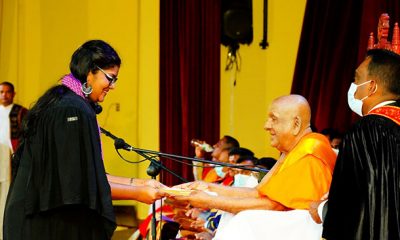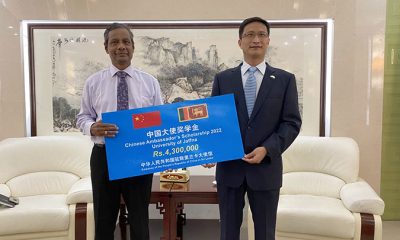Opinion
Connecting beyond Boundaries and Imaging sans Structures: Reflections of My Fulbright Experiences

A speech made
by Prof. Gamini Keerawella
I deem it indeed a great honour to be invited me to deliver the keynote address, on the occasion of the 75th anniversary of the global Fulbright programme. For that, first of all, I do thank the US–Sri Lanka Fulbright Commission and its Executive Director, Ms. Sandharsee Gunawardena for giving me this opportunity.
I thought I should make use of this occasion to reflect on my Fulbright experience, unpacking the true value of the Fulbright programme in the changed context from the perspective of an academic, coming from the global South who benefitted from the Fulbright scholar exchanges.
The Fulbright programme is considered the US flagship international exchange programme, founded in August 1946, just 11 month after the end of Second World War, initiated by Senator William Fulbright, with the support of President Harry Truman and the Secretary of State Dean Acheson. Still, the dust created by WW-II was not settled. At the end of the WWII, the United States emerged as the Superpower with a new global role and reach. It was in this context that Senator William Fulbright presented the Fulbright Bill to amend the Surplus Property act of 1944 to use the revenue from the sales of US war properties in other countries to fund the educational exchanges between the US and participating countries. This birth trait of the Fulbright programme gave rise to its unique feature: the bilateralism. It is reflected in many National Fulbright Commissions such as the US-Sri Lanka Fulbright commission. As a political visionary from the standpoint of US strategic interests, Senator William Fulbright believed that education and diplomacy would be invaluable tools of US foreign policy in the changed international context after the II World War.
Before long, the international politics in the Post-War world was determined by the global-scale, multi-faceted strategic completion between the United States and the Soviet Union, identified as the Cold War. The world politics was polarised into two poles, the Soviet and the Western. The de-colonisation process gave birth to another category in global politics termed as the Global South. The both superpowers were competing in the Global South each other for influence. In this context, the Fulbright programme became a key foreign policy tool of the United States. That is the origin of the Fulbright exchange programme.
During the last 75 years, the Fulbright programme expanded rapidly, changing its purpose and character. It has generated consequences and dividends, unexpected by its founders. The first country to sign Fulbright agreement was China in 1947; it was followed by Burma. Today, each year bout 800 scholars and ,000 US students receive Fulbright awards and go abroad while 4,000 foreign students and 900 scholars receive awards to come to US. In the past 75 years, over 310,000 Fulbright students, scholars and teachers benefitted by the exchange programme.
Before I reflect on my Fulbright experience, please permit me to reveal my background briefly to place it in a proper political and historical context.
I think I belonged to the first post-colonial generation in Sri Lanka, born after independence. I also represent the Post-1956 generation, a commonly used cliché to denote this generation 0The Children of 56. My parents were ardent supporters of the 1956 political change. To cut a long story short, we manifested the strengths and the weaknesses of the so-called Children of 56.
I come from a rural/village background and not really from urban. Educated from, K/Uduwa School, Galagedara up to the 5th grade, where my parents were teachers. From 6th grade, I moved to the Gampola Central College. My entire school education was in Sinhala medium. I gained admission to the University of Peradeniya in 1968.
We witnessed the evolution of post-colonial social and political environment in the country. We saw how the collapse of Bamumu Kulaya (Brown Sahibs) which coincided with the emergence and dominance of a new political class. During our teens, the youth political culture of the country was highly influenced by New Left political ideologies. The Cuban Revolution inspired our generation and Che Guevara was our hero.
Our worldview was shaped by the Anti-Vietnam War Movement and U.S. intervention in South-East Asia. The military coup in Chile against Elected President Salvador Allende and its CIA involvements further reinforced our anti-American sentiment. America is nothing but the US state, its corporate interests and the inner state. We did not see anything beyond ‘Ugly America’.
We were avowedly anti-American and uncritically anti-American. We had only straitjacket, stereotype image on America: The Yankee imperialism: threat to the world. The world was very simple: we were progressive and we wore red hats. The others were reactionary; they wore black hats.
I gained admission to the Peradeniya University in 1968. It was the heyday of the University of Peradeniya. The Sri Lankan universities at the time were centres of radical left politics.
In the academic sphere, we had a well-qualified academic staff. We followed the conventional British academic traditions. Disciplinary boundaries were very high; no inter-disciplinary dialogue at all. Academic hierarchy was also maintained rigidly.
In the sophomore year at the University of Peradeniya, I got involved in the youth front of the JVP. As a result, after the 1971 youth uprising I was arrested and detained in the Bogambara Prison. At the end of 1973, I was released from Bogambara. I resumed my undergraduate studies at the University of Peradeniya in 1974 and sat my final Examination in 1975. As I showed good promise in my BA (Hons.) examination, I was recruited to the academic staff of my alma mater in 1976. It was the turning point in my life.
I proceeded to Canada for my post-graduate studies in 1980. In 1982, I obtained my Maters from the University of Windsor, Canada, by presenting a thesis on the origins of the New Left in Sri Lanka and the 1971 uprising. I compared Sri Lankan New Left with the South American New Left. It helped me to examine critically my new-left influence.
For my doctoral studies, I enrolled myself to the University of British Columbia, Canada. I decided to combine Strategic Studies with History. I worked on the growth of Superpower Naval rivalry in the Indian Ocean and Sri Lankan Response. It was a unique experience and I went through real disciplinary metamorphosis there. I was in the Department of History. My supervisor was from the Department of Asian Studies; I took causes in International Relations from the Department of political science. My external supervisor was Prof Howard Wriggins, Professor of Political Science of University of Columbia, New York, from another country.
During my doctoral studies at UBC, I was introduced to the on-going academic discourse on ‘National Security’. By then, the theoretical parameters marked by the Realist School dominated the field of Security Studies were predominant. It was mainly state–centered and the security of the state in an anarchic international environment was the focal concern of the national security.
In the main stream of thinking, national security was defined as the protection of territorial integrity of the state vis-à-vis the threats originated from the external sources. The internal security of the state was taken for granted and, if there was any concern, it was dealt under the rubric of internal law and order problematic. In this strand of analysis, the national, security was nothing but the politico-military security of the state; the ‘hard’ military strategic security took precedent over the ‘soft’ economic dimension of security. In the Cold War context, the preoccupation of the discipline was mainly to analyse the central military strategic balance of the superpowers and their defense strategies. The concerns relating to the prevention of a nuclear war between the superpowers constituted the core of the international security studies. UBC is a great seat of learning and research. From University of British Columbia, I received the license to the world of academia, Ph.D.
In 1993, I won the Fulbright Post-doctoral Fellowshi to join the University of California, Berkeley. Berkeley is, no doubt, a unique university. It was the birthplace of the Free Speech Movement and the Flower Power Movement of the 1960S. The impact of the Free Speech Movement and the Flower Generation was still visible at Berkeley. The research that I conducted during my Fellowship at Berkeley was ‘The Security of Small States in the Indian Ocean in the Post-Cold War context’.
In a vibrant academic environment at Berkeley, I was able to rethink the concept of national security. I myself deconstructed the Concept of National Security. What does ‘national’ in national security mean? What is security? What is national security? Can we equate National Security with State Security? What is really meant by security of the state? The real issue here is how to define the security of the state, going beyond narrow territorial confines. On the one hand, the state is a legal abstraction. On the other, it has a territorial basis and institutional framework of its own. The ideological basis of the state is the most important aspect of the state because it binds the territorial base with the human and institutional base with state. In addition, institutional set up of the state and human base of the state should also be taken into account.
The narrow definition of protection of territorial integrity from external threats is found to be inadequate in the face of new threat scenarios. In many third world states, the territorial integrity is challenged not externally but internally.
The territory is only one element of the state. The other elements of state including people and their security must also be taken into account in the security configuration.
As soon as people are taken as a referent object of national security, the analysis of threat and threat perceptions has to be invariably changed. The security building process involves the ability to meet and dispel threats and the reduction of vulnerabilities.
With the recognition of people as a reference of security, in its own rights, a variety of threats and vulnerabilities enter into the forefront of security analysis with different types of agents and sources of threat.
This line of thinking took me to the dual role of the state. One the one hand, State is the security provider; on the other hand it was a source of threat. Human rights, Rule of law, constitutionality and good governance become national security issues.
Berkeley experience under Fulbright Fellowship helped me to going beyond borders. It is not simply building connectivity crossing territorial boundaries. Indeed, crossing territorial boundaries are important. The territorial boundaries does not mean the physical territories. In our thinking, we are highly circumscribed by a small Island mentality. The besieged mentality in a small island is often presented ad patriotism. It is not patriotism. In order to get out of this besieged mentality you need to cross boundaries.
Crossing the pedagogic boundaries is equally important. Other two types of crossing boundaries are also equally important: First, Building connectivity, crossing theoretical borders within the discipline; Second, Building connectivity crossing disciplinary borders. It convinced me that symbiosis of approaches provides a new Synergy to view things from fresh perspective.
Further more, my Fulbright experience helped me to visualise the United States sans structures. In our undergraduate days we entertained a simple and monolithic view. In the world is of two categories: good and bad – Whit Hats and Black Hats mentality. Our earlier image of US was linked only to the set structure- The US State. It is true that State and society are inseparable entities. But I was convinced by my Fulbright experience to view ‘other America’ too. While admitting domination of corporate sector and the dominance of ‘inner state’, we need to pay attention to other social and political dynamics to understand complexity of US polity. It is not one colour Images. US is a country of many governments, many images, divers colors- just like proverbial bride’s gown; something green, something blue, something yellow and something green.
The most virulent critics of the US system can be found with the US. The vibrancy of US higher education institutions is remarkable. The most innovative
and radical thinking can be found in the US academic institutions. The Chicago school and writings of Jurgen Habermas is not an isolated example. The discourse on Gramsci, Foucault and Subaltern studies inspire Social Sciences in many key US academic institutions.
US system is complex and multifaceted. Internal dynamics of the system and checks and balances constituted an integral element of US system. This contributed to change the my lop-sided earlier view on America
US is not only the US State and its cooperate interests. The other-side of America is different. Fulbright experience helped me to separate US state and US society, to view the US people sans set structures. The US state, its apparatus and the US inner state constitute one dimension of America. There is other side of America, consisting great people US contribution to modern art and culture is great and we need view them delinking them with US state structures.
Contribution of US Musicians such as Garth Brooks, Elvis Presley, Eagles, and Michael Jackson reminds us the existence of other America. The great American poets such T. S. Eliot, Edgar Allan Poe, E.E. Cummings, Robert Frost reminds us the beauty of American culture alone with American Novelists such as F. Scott Fitzgerald, Ernest Hemingway. Mark Twain, Toni Morrison. John Steinbeck. While criticizing US state, its corporate interests and inner state, we enjoy US contribution to the culture of our age. Out attitude towards US state does not prevent us from enjoying US films such as Citizen Kane, The Godfather, A Space Odyssey, Gone with the wind, Lawrence of Arabia, The King and I and The Sound of Music.
In the new millennium, the significance of public diplomacy, such as the Fulbright scholar exchange program, must be viewed from a fresh perspective. The eclipse of utility of hard power and the increasing impotence of gunboat diplomacy highlights the soft power. In this context, not only the developments in the Wall Street but also developments in the main street are also come forward to determine the agenda of global politics. Referring to our backyard, the Indian Ocean, Robert D, Kaplan observed “for the first time since the Portuguese onslaught in the region in the early 16th century, West’s power there is in decline, however subtly and relatively. The Indians and the Chinese will enter into a dynamic great-power rivalry in these waters, with their shared economic interests as major trading partners locking them in an uncomfortable embrace. The United States, meanwhile, will serve as a stabilizing power in this newly complex area. Indispensability, rather than dominance, must be its goal”. Mobilizing US soft power potential is the best way to achieve ‘indispensability’.
The Fulbright exchanges highlighted the power of citizen diplomacy. Further, it gave the wider world an access to the positive contribution of the centers of leaning and knowledge, art and literature of the United States. Above all, it helped imaging US cans structures and building connectivity crossing many forms of boundaries. To conclude, I wish to quote Senator William Fulbright. He said on the occasion of 40th anniversary of the Fulbright Program in 1986, “Perhaps the greatest power of such intellectual exchanges is to convert nations into peoples and to translate ideologies into human aspirations. To continue to build more weapons, especially mote exotic and unpredictable machines of war, will not build trust and confidence”.
Opinion
Child food poverty: A prowling menace
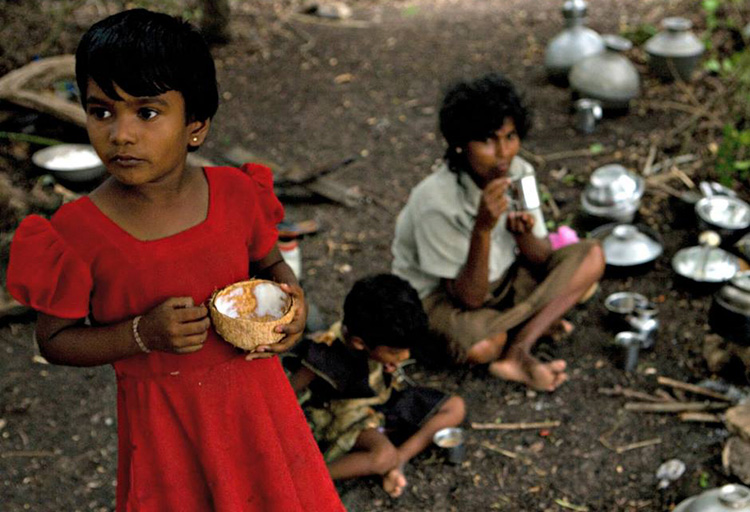
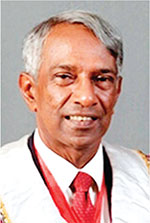 by Dr B.J.C.Perera
by Dr B.J.C.Perera
MBBS(Cey), DCH(Cey), DCH(Eng), MD(Paed), MRCP(UK), FRCP(Edin),
FRCP(Lon), FRCPCH(UK), FSLCPaed, FCCP, Hony FRCPCH(UK), Hony. FCGP(SL)
Specialist Consultant Paediatrician and Honorary Senior Fellow,
Postgraduate Institute of Medicine, University of Colombo, Sri Lanka.
Joint Editor, Sri Lanka Journal of Child Health
In an age of unprecedented global development, technological advancements, universal connectivity, and improvements in living standards in many areas of the world, it is a very dark irony that child food poverty remains a pressing issue. UNICEF defines child food poverty as children’s inability to access and consume a nutritious and diverse diet in early childhood. Despite the planet Earth’s undisputed capacity to produce enough food to nourish everyone, millions of children still go hungry each day. We desperately need to explore the multifaceted deleterious effects of child food poverty, on physical health, cognitive development, emotional well-being, and societal impacts and then try to formulate a road map to alleviate its deleterious effects.
Every day, right across the world, millions of parents and families are struggling to provide nutritious and diverse foods that young children desperately need to reach their full potential. Growing inequities, conflict, and climate crises, combined with rising food prices, the overabundance of unhealthy foods, harmful food marketing strategies and poor child-feeding practices, are condemning millions of children to child food poverty.
In a communique dated 06th June 2024, UNICEF reports that globally, 1 in 4 children; approximately 181 million under the age of five, live in severe child food poverty, defined as consuming at most, two of eight food groups in early childhood. These children are up to 50 per cent more likely to suffer from life-threatening malnutrition. Child Food Poverty: Nutrition Deprivation in Early Childhood – the third issue of UNICEF’s flagship Child Nutrition Report – highlights that millions of young children are unable to access and consume the nutritious and diverse diets that are essential for their growth and development in early childhood and beyond.
It is highlighted in the report that four out of five children experiencing severe child food poverty are fed only breastmilk or just some other milk and/or a starchy staple, such as maize, rice or wheat. Less than 10 per cent of these children are fed fruits and vegetables and less than 5 per cent are fed nutrient-dense foods such as eggs, fish, poultry, or meat. These are horrendous statistics that should pull at the heartstrings of the discerning populace of this world.
The report also identifies the drivers of child food poverty. Strikingly, though 46 per cent of all cases of severe child food poverty are among poor households where income poverty is likely to be a major driver, 54 per cent live in relatively wealthier households, among whom poor food environments and feeding practices are the main drivers of food poverty in early childhood.
One of the most immediate and visible effects of child food poverty is its detrimental impact on physical health. Malnutrition, which can result from both insufficient calorie intake and lack of essential nutrients, is a prevalent consequence. Chronic undernourishment during formative years leads to stunted growth, weakened immune systems, and increased susceptibility to infections and diseases. Children who do not receive adequate nutrition are more likely to suffer from conditions such as anaemia, rickets, and developmental delays.
Moreover, the lack of proper nutrition can have long-term health consequences. Malnourished children are at a higher risk of developing chronic illnesses such as heart disease, diabetes, and obesity later in life. The paradox of child food poverty is that it can lead to both undernutrition and overnutrition, with children in food-insecure households often consuming calorie-dense but nutrient-poor foods due to economic constraints. This dietary pattern increases the risk of obesity, creating a vicious cycle of poor health outcomes.
The impacts of child food poverty extend beyond physical health, severely affecting cognitive development and educational attainment. Adequate nutrition is crucial for brain development, particularly in the early years of life. Malnutrition can impair cognitive functions such as attention, memory, and problem-solving skills. Studies have consistently shown that malnourished children perform worse academically compared to their well-nourished peers. Inadequate nutrition during early childhood can lead to reduced school readiness and lower IQ scores. These children often struggle to concentrate in school, miss more days due to illness, and have lower overall academic performance. This educational disadvantage perpetuates the cycle of poverty, as lower educational attainment reduces future employment opportunities and earning potential.
The emotional and psychological effects of child food poverty are profound and are often overlooked. Food insecurity creates a constant state of stress and anxiety for both children and their families. The uncertainty of not knowing when or where the next meal will come from can lead to feelings of helplessness and despair. Children in food-insecure households are more likely to experience behavioural problems, including hyperactivity, aggression, and withdrawal. The stigma associated with poverty and hunger can further exacerbate these emotional challenges. Children who experience food poverty may feel shame and embarrassment, leading to social isolation and reduced self-esteem. This psychological toll can have lasting effects, contributing to mental health issues such as depression and anxiety in adolescence and adulthood.
Child food poverty also perpetuates cycles of poverty and inequality. Children who grow up in food-insecure households are more likely to remain in poverty as adults, continuing the intergenerational transmission of disadvantage. This cycle of poverty exacerbates social disparities, contributing to increased crime rates, reduced social cohesion, and greater reliance on social welfare programmes. The repercussions of child food poverty ripple through society, creating economic and social challenges that affect everyone. The healthcare costs associated with treating malnutrition-related illnesses and chronic diseases are substantial. Additionally, the educational deficits linked to child food poverty result in a less skilled workforce, which hampers economic growth and productivity.
Addressing child food poverty requires a multi-faceted approach that tackles both immediate needs and underlying causes. Policy interventions are crucial in ensuring that all children have access to adequate nutrition. This can include expanding social safety nets, such as food assistance programmes and school meal initiatives, as well as targeted manoeuvres to reach more vulnerable families. Ensuring that these programmes are adequately funded and effectively implemented is essential for their success.
In addition to direct food assistance, broader economic and social policies are needed to address the root causes of poverty. This includes efforts to increase household incomes through living wage policies, job training programs, and economic development initiatives. Supporting families with affordable childcare, healthcare, and housing can also alleviate some of the financial pressures that contribute to food insecurity.
Community-based initiatives play a vital role in combating child food poverty. Local food banks, community gardens, and nutrition education programmes can help provide immediate relief and promote long-term food security. Collaborative efforts between government, non-profits, and the private sector are necessary to create sustainable solutions.
Child food poverty is a profound and inescapable issue with far-reaching consequences. Its deleterious effects on physical health, cognitive development, emotional well-being, and societal stability underscore the urgent need for comprehensive action. As we strive for a more equitable and just world, addressing child food poverty must be a priority. By ensuring that all children have access to adequate nutrition, we can lay the foundation for a healthier, more prosperous future for individuals and society as a whole. The fight against child food poverty is not just a moral imperative but an investment in our collective future. Healthy, well-nourished children are more likely to grow into productive, contributing members of society. The benefits of addressing this issue extend beyond individual well-being, enhancing economic stability and social harmony. It is incumbent upon us all to recognize and act upon the understanding that every child deserves the right to adequate nutrition and the opportunity to thrive.
Despite all of these existent challenges, it is very definitely possible to end child food poverty. The world needs targeted interventions to transform food, health, and social protection systems, and also take steps to strengthen data systems to track progress in reducing child food poverty. All these manoeuvres must comprise a concerted effort towards making nutritious and diverse diets accessible and affordable to all. We need to call for child food poverty reduction to be recognized as a metric of success towards achieving global and national nutrition and development goals.
Material from UNICEF reports and AI assistance are acknowledged.
Opinion
Do opinion polls matter?
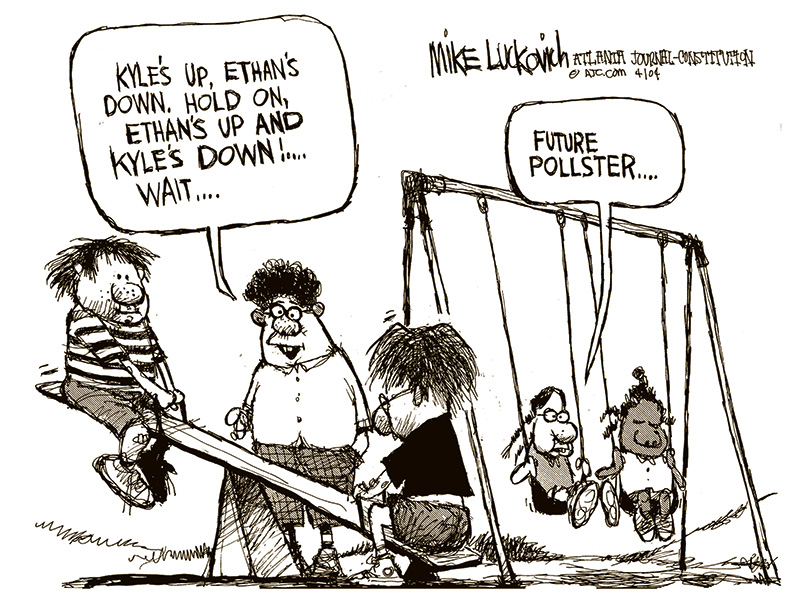
By Dr Upul Wijayawardhana
The colossal failure of not a single opinion poll predicting accurately the result of the Indian parliamentary election, the greatest exercise in democracy in the world, raises the question whether the importance of opinion polls is vastly exaggerated. During elections two types of opinion polls are conducted; one based on intentions to vote, published during or before the campaign, often being not very accurate as these are subject to many variables but exit polls, done after the voting where a sample tally of how the voters actually voted, are mostly accurate. However, of the 15 exit polls published soon after all the votes were cast in the massive Indian election, 13 vastly overpredicted the number of seats Modi’s BJP led coalition NDA would obtain, some giving a figure as high as 400, the number Modi claimed he is aiming for. The other two polls grossly underestimated predicting a hung parliament. The actual result is that NDA passed the threshold of 272 comfortably, there being no landslide. BJP by itself was not able to cross the threshold, a significant setback for an overconfident Mody! Whether this would result in less excesses on the part of Modi, like Muslim-bashing, remains to be seen. Anyway, the statement issued by BJP that they would be investigating the reasons for failure rather than blaming the process speaks very highly of the maturity of the democratic process in India.
I was intrigued by this failure of opinion polls as this differs dramatically from opinion polls in the UK. I never failed to watch ‘Election night specials’ on BBC; as the Big Ben strikes ‘ten’ (In the UK polls close at 10pm} the anchor comes out with “Exit polls predict that …” and the actual outcome is often almost as predicted. However, many a time opinion polls conducted during the campaign have got the predictions wrong. There are many explanations for this.
An opinion poll is defined as a research survey of public opinion from a particular sample, the origin of which can be traced back to the 1824 US presidential election, when two local newspapers in North Carolina and Delaware predicted the victory of Andrew Jackson but the sample was local. First national survey was done in 1916 by the magazine, Literary Digest, partly for circulation-raising, by mailing millions of postcards and counting the returns. Of course, this was not very scientific though it accurately predicted the election of Woodrow Wilson.
Since then, opinion polls have grown in extent and complexity with scientific methodology improving the outcome of predictions not only in elections but also in market research. As a result, some of these organisations have become big businesses. For instance, YouGov, an internet-based organisation co-founded by the Iraqi-born British politician Nadim Zahawi, based in London had a revenue of 258 million GBP in 2023.
In Sri Lanka, opinion polls seem to be conducted by only one organisation which, by itself, is a disadvantage, as pooled data from surveys conducted by many are more likely to reflect the true situation. Irrespective of the degree of accuracy, politicians seem to be dependent on the available data which lend explanations to the behaviour of some.
The Institute for Health Policy’s (IHP) Sri Lanka Opinion Tracker Survey has been tracking the voting intentions for the likely candidates for the Presidential election. At one stage the NPP/JVP leader AKD was getting a figure over 50%. This together with some degree of international acceptance made the JVP behave as if they are already in power, leading to some incidents where their true colour was showing.
The comments made by a prominent member of the JVP who claimed that the JVP killed only the riff-raff, raised many questions, in addition to being a total insult to many innocents killed by them including my uncle. Do they have the authority to do so? Do extra-judicial killings continue to be JVP policy? Do they consider anyone who disagrees with them riff-raff? Will they kill them simply because they do not comply like one of my admired teachers, Dr Gladys Jayawardena who was considered riff-raff because she, as the Chairman of the State Pharmaceutical Corporation, arranged to buy drugs cheaper from India? Is it not the height of hypocrisy that AKD is now boasting of his ties to India?
Another big-wig comes with the grand idea of devolving law and order to village level. As stated very strongly, in the editorial “Pledges and reality” (The Island, 20 May) is this what they intend to do: Have JVP kangaroo-courts!
Perhaps, as a result of these incidents AKD’s ratings has dropped to 39%, according to the IHP survey done in April, and Sajith Premadasa’s ratings have increased gradually to match that. Whilst they are level pegging Ranil is far behind at 13%. Is this the reason why Ranil is getting his acolytes to propagate the idea that the best for the country is to extend his tenure by a referendum? He forced the postponement of Local Governments elections by refusing to release funds but he cannot do so for the presidential election for constitutional reasons. He is now looking for loopholes. Has he considered the distinct possibility that the referendum to extend the life of the presidency and the parliament if lost, would double the expenditure?
Unfortunately, this has been an exercise in futility and it would not be surprising if the next survey shows Ranil’s chances dropping even further! Perhaps, the best option available to Ranil is to retire gracefully, taking credit for steadying the economy and saving the country from an anarchic invasion of the parliament, rather than to leave politics in disgrace by coming third in the presidential election. Unless, of course, he is convinced that opinion polls do not matter and what matters is the ballots in the box!
Opinion
Thoughtfulness or mindfulness?

By Prof. Kirthi Tennakone
ktenna@yahoo.co.uk
Thoughtfulness is the quality of being conscious of issues that arise and considering action while seeking explanations. It facilitates finding solutions to problems and judging experiences.
Almost all human accomplishments are consequences of thoughtfulness.
Can you perform day-to-day work efficiently and effectively without being thoughtful? Obviously, no. Are there any major advancements attained without thought and contemplation? Not a single example!
Science and technology, art, music and literary compositions and religion stand conspicuously as products of thought.
Thought could have sinister motives and the only way to eliminate them is through thought itself. Thought could distinguish right from wrong.
Empathy, love, amusement, and expression of sorrow are reflections of thought.
Thought relieves worries by understanding or taking decisive action.
Despite the universal virtue of thoughtfulness, some advocate an idea termed mindfulness, claiming the benefits of nurturing this quality to shape mental wellbeing. The concept is defined as focusing attention to the present moment without judgment. A way of forgetting the worries and calming the mind – a form of meditation. A definition coined in the West to decouple the concept from religion. The attitude could have a temporary advantage as a method of softening negative feelings such as sorrow and anger. However, no man or woman can afford to be non-judgmental all the time. It is incompatible with indispensable thoughtfulness! What is the advantage of diverting attention to one thing without discernment during a few tens of minute’s meditation? The instructors of mindfulness meditation tell you to focus attention on trivial things. Whereas in thoughtfulness, you concentrate the mind on challenging issues. Sometimes arriving at groundbreaking scientific discoveries, solution of mathematical problems or the creation of masterpieces in engineering, art, or literature.
The concept of meditation and mindfulness originated in ancient India around 1000 BCE. Vedic ascetics believed the practice would lead to supernatural powers enabling disclosure of the truth. Failing to meet the said aspiration, notwithstanding so many stories in scripture, is discernable. Otherwise, the world would have been awakened to advancement by ancient Indians before the Greeks. The latter culture emphasized thoughtfulness!
In India, Buddha was the first to deviate from the Vedic philosophy. His teachers, Alara Kalama and Uddaka Ramaputra, were adherents of meditation. Unconvinced of their approach, Buddha concluded a thoughtful analysis of the actualities of life should be the path to realisation. However, in an environment dominated by Vedic tradition, meditation residually persisted when Buddha’s teachings transformed into a religion.
In the early 1970s, a few in the West picked up meditation and mindfulness. We Easterners, who criticize Western ideas all the time, got exalted after seeing something Eastern accepted in the Western circles. Thereafter, Easterners took up the subject more seriously, in the spirit of its definition in the West.
Today, mindfulness has become a marketable commodity – a thriving business spreading worldwide, fueled largely by advertising. There are practice centres, lessons onsite and online, and apps for purchase. Articles written by gurus of the field appear on the web.
What attracts people to mindfulness programmes? Many assume them being stressed and depressed needs to improve their mental capacity. In most instances, these are minor complaints and for understandable reasons, they do not seek mainstream medical interventions but go for exaggeratedly advertised alternatives. Mainstream medical treatments are based on rigorous science and spell out both the pros and cons of the procedure, avoiding overstatement. Whereas the alternative sector makes unsubstantiated claims about the efficacy and effectiveness of the treatment.
Advocates of mindfulness claim the benefits of their prescriptions have been proven scientifically. There are reports (mostly in open-access journals which charge a fee for publication) indicating that authors have found positive aspects of mindfulness or identified reasons correlating the efficacy of such activities. However, they rarely meet standards normally required for unequivocal acceptance. The gold standard of scientific scrutiny is the statistically significant reproducibility of claims.
If a mindfulness guru claims his prescription of meditation cures hypertension, he must record the blood pressure of participants before and after completion of the activity and show the blood pressure of a large percentage has stably dropped and repeat the experiment with different clients. He must also conduct sessions where he adopts another prescription (a placebo) under the same conditions and compares the results. This is not enough, he must request someone else to conduct sessions following his prescription, to rule out the influence of the personality of the instructor.
The laity unaware of the above rigid requirements, accede to purported claims of mindfulness proponents.
A few years ago, an article published and widely cited stated that the practice of mindfulness increases the gray matter density of the brain. A more recent study found there is no such correlation. Popular expositions on the subject do not refer to the latter report. Most mindfulness research published seems to have been conducted intending to prove the benefits of the practice. The hard science demands doing the opposite as well-experiments carried out intending to disprove the claims. You need to be skeptical until things are firmly established.
Despite many efforts diverted to disprove Einstein’s General Theory of Relativity, no contradictions have been found in vain to date, strengthening the validity of the theory. Regarding mindfulness, as it stands, benefits can neither be proved nor disproved, to the gold standard of scientific scrutiny.
Some schools in foreign lands have accommodated mindfulness training programs hoping to develop the mental facility of students and Sri Lanka plans to follow. However, studies also reveal these exercises are ineffective or do more harm than good. Have we investigated this issue before imitation?
Should we force our children to focus attention on one single goal without judgment, even for a moment?
Why not allow young minds to roam wild in their deepest imagination and build castles in the air and encourage them to turn these fantasies into realities by nurturing their thoughtfulness?
Be more thoughtful than mindful?




